
The term “guerrilla marketing” conjures up some comical images for me.
I see professionally dressed guerrilla fighters sipping black jungle coffee, printing propaganda posters, and tweeting memes from their satellite laptops.
Rather disappointingly, though, guerrilla marketing doesn’t have any involvement from the freedom-fighter profession.
Not unlike guerrilla fighters who utilize unorthodox tactics while engaging in guerrilla warfare, guerrilla marketers use surprising and unconventional strategies to promote a product or service.
It’s an ingenious way to shed the tired, overused, traditional marketing tactics that most customers see straight through and approach things from a rather different angle.
This can make it an amazingly powerful marketing tool and one you’ll definitely want to leverage to the advantage of your brand.
How?
Well, smudge a little green paint on your cheekbones, and let’s go deep. Deep into the jungle that is guerrilla marketing.
Guerrilla marketing is a set of marketing tools, techniques, and practices to connect directly to customers and leave a lasting, memorable impression.
Just like referral program tools, experiential marketing focuses on creating memorable experiences that inspire customers to share and promote a brand. The ultimate goal of guerilla marketing is to get customers to remember a brand’s products in a way they are not accustomed to.
The term was first popularized by a guy who goes by the name of Jay Conrad Levinson. Jay’s 1984 book Guerrilla Marketing was so successful that it was named by Time Magazine as one of the top 25 most influential business management books, selling over 21 million copies. It was so influential, that it has been dubbed as one of the top marketing books ever written and has since been translated into 62 different languages worldwide.
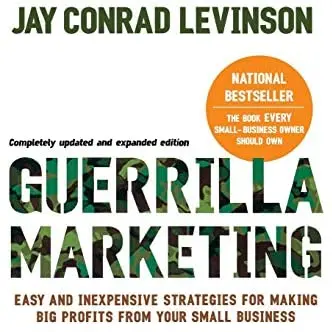
Within Jay Conrad Levinson’s book, he outlined an unconventional but very effective set of marketing tools that are still used heavily to this day. I’ll detail these strategies and provide examples of how to implement them below.
Guerrilla marketing can be an incredibly effective marketing campaign, particularly for small businesses. It’s low-cost and makes use of tactical strategies like word of mouth, viral marketing, or ambient marketing that have proven again and again to be very effective.
By its subtle, canny, and creative nature, guerrilla marketing is a great way to boost brand awareness, brand loyalty, and brand exposure.
One of the things that make guerrilla marketing strategies so attractive for many companies is that it’s cost-effective. Guerrilla marketing draws upon creativity and inspiration, instead of monetary investment.
Just like a guerrilla fighter, guerrilla marketers have to be crafty, artful, and rather innovative when developing good guerrilla marketing tactics. In a sense, they use low-cost and unconventional methods to not only draw the attention of new customers to their brand but also to repurpose old marketing techniques to further engage their current customers.
So what kind of guerrilla marketing can you leverage to promote your business?
Let’s take a look.
There are many different ways to stealthily practice guerrilla marketing. Depending on your marketing budget and the overall creativity of your marketing team, you may want to try one of these different types of guerrilla marketing.
Out of all the marketing ideas you’ve heard of, this one probably sounds like one of the weirdest. Bear with me though, event ambush marketing simply leverages the attention of an audience that is currently attending an event or while in a captive setting.
Usually something like a sporting event, music gig, or even while in a subway station.
A person within this setting is either reluctant to leave, as they’ve paid to be there, or is so interested in what is unfolding in front of them that they simply can’t miss the action.
These kinds of settings offer guerrilla marketers a very unique opportunity that they don’t often get: their audience’s involuntary yet undivided attention.

Stella Artois pulled this off in an epic (and controversial) campaign at the 2011 US Open where they placed their ads around the event as if they were the official sponsor (though they were not).
The upfront costs of an event ambush marketing aren't that expensive. Often, an event ambush occurs without the permission of an event sponsor. Therefore, it is a very affordable yet impactful form of marketing.
Examples of Event Ambush Marketing
Astroturfing is among one of the more controversial and arguably less tactful guerrilla marketing strategies. Just like astroturf is artificial grass that mimics the real thing, astroturf marketing uses fake endorsements to mimic social proof.
The most common form of astroturfing that we will see in modern marketing involves some sort of hype or publicity. This hype is usually generated through online blogs, online forums, or even at a place of business.
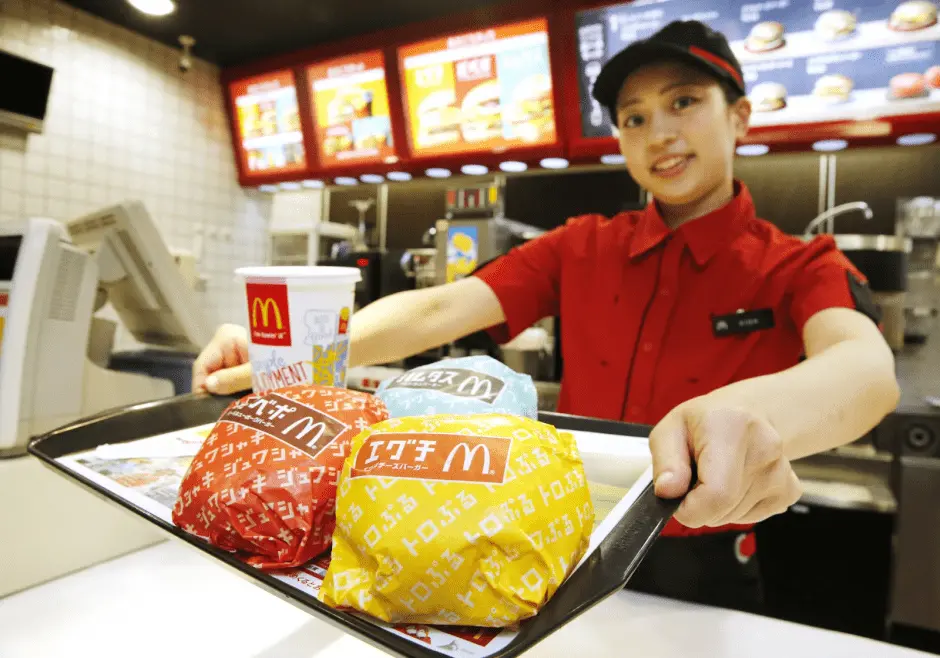
A perfect example of this is McDonald’s admitting that they compensated around 1,000 customers. The paid customers stood in line for a quarter pounder in one of their Japanese restaurants, appearing as if they simply couldn’t wait to get a hold of one of McDonald’s most famous burgers.
Individuals are also paid to leave positive reviews, give positive testimonials, or comment positively about a company’s products or services often on a form of social media.
These reviewers often have never used or purchased anything from this company; they are simply there to leave content that will persuade others to send money with the astroturfing brand. Even if you’re ethically running review outreach campaigns, you’ll want to clean your contact list first. Using an email finder to source accurate contacts before verification makes the process more effective, and an email verifier helps you avoid bounce rates, spam traps, and accidental damage to your domain reputation.
It is important to note that Astroturfing does have some serious drawbacks.
Should potential customers catch wind of this marketing strategy, it will often leave a very bad taste in their mouths, and this can lead to some serious implications for the company. It can damage their reputation, the authenticity of their products and services, or, at worse, lead to some form of legal action.
Why would a company risk all of this?
Because astroturfing is not only incredibly budget-friendly but it can also be very effective, minimizing traditional marketing efforts and reducing costs. This often makes the risk of damaging a business's reputation extremely alluring to some companies.
Examples of Astroturfing Marketing
Buzz marketing is the antithesis of astroturfing. It leverages genuine endorsements, particularly from high-profile individuals or celebrities, and uses this to increase their brand awareness and brand exposure.
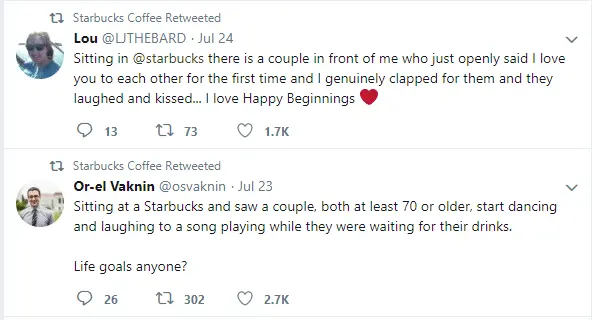
A very cute yet prime example of buzz marketing is these Tweets from a couple of Starbucks customers. They’ve connected a quite emotional yet positive and organic experience with the Starbucks brand. Not only helping Starbucks’ image but also promoting their products.
Unlike astroturfing, these high-profile endorsements and recommendations come naturally and organically, without the business having to pay for them. Buzz marketing relies heavily on amplified and organic word-of-mouth, using the buzz created around its brand to cement the product or service as a must-have purchase.
Buzz marketing can be incredibly effective but often hard to generate as it often occurs without warning and without encouragement. But as hard as it is to obtain, buzz marketing is incredibly cost-effective as it usually requires minimal involvement as it’s a naturally occurring phenomenon.
Examples of Buzz Marketing
Experiential marketing is a guerrilla marketing strategy that encourages and engages customers to participate in the growth and success of a business. Rather than the traditional marketing model, where customers are passive participants in consuming advertising messages, experiential marketers hold the belief that customers should be active participants in a marketing campaign.
Experiential marketers use creative marketing to encourage the co-creation of a marketing campaign to help customers develop an emotional attachment and solid relationship with a business. This attachment leads to a beneficially mutualistic relationship, the brand secures regular business and a customer has access to products and services that they love and truly believe in.

For example, during the FIFA World Cup in Zurich, Coca-Cola set up a VR experience that allowed bystanders to play a mini-game of soccer. While a VR experience such as this isn’t accessible to many marketers, it’s a good example of how brands can get consumers engaged with their business in a fun and interactive manner.
And really, the cost of experiential marketing can be as affordable or expensive as a business wishes to make it. Anything from as cheap as a grassroots-led meetup or as elaborate as an immersive and memorable experience like a theme industry party.
Examples of Experiential Marketing
Grassroots marketing is one of those guerrilla marketing campaigns that is especially effective for small businesses. Instead of spending big bucks on elaborate advertising ventures, a brand can engage with their target audience through a common course or mutually shared vision.
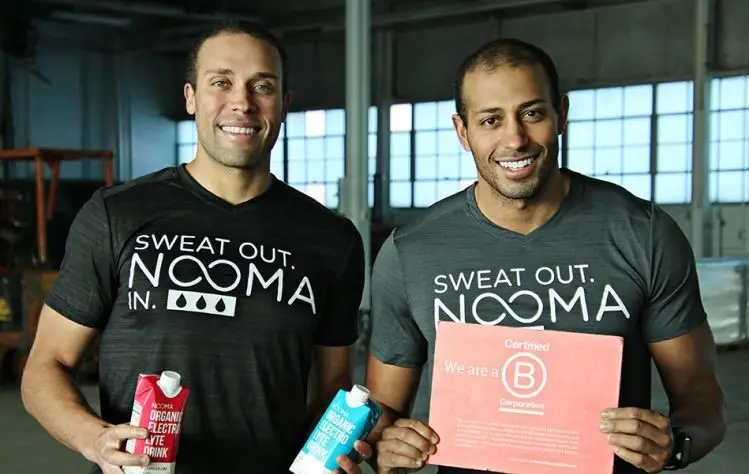
Nooma sports drinks are a great example of grassroots marketing. Jared and Brandon, two brothers from Cleveland, kick-started their brand by leveraging health-minded athletes’ demands for a healthy sports drink alternative while also supporting sporting events in their local area.
A grassroots guerrilla marketing usually targets a small customer base and hopes that the group will spread a business’ message or vision to a much larger audience.
Grassroots marketing often makes use of less traditional, unconventional, and creative marketing strategies. Therefore, it normally costs less than more conventional marketing ideas while still having the potential to produce big results.
Examples of Grassroots Marketing
Stealth marketing is a guerrilla marketing campaign that targets customers through subtle and creative marketing strategies. More often than not, this form of marketing advertises a product or service to a person without them realizing they are being marketed.
There are many tactic strategies that stealth marketers use, the most familiar being product placement and undercover marketing. As seen here by FedEx in Tom Hanks’ very popular film, Castaway.
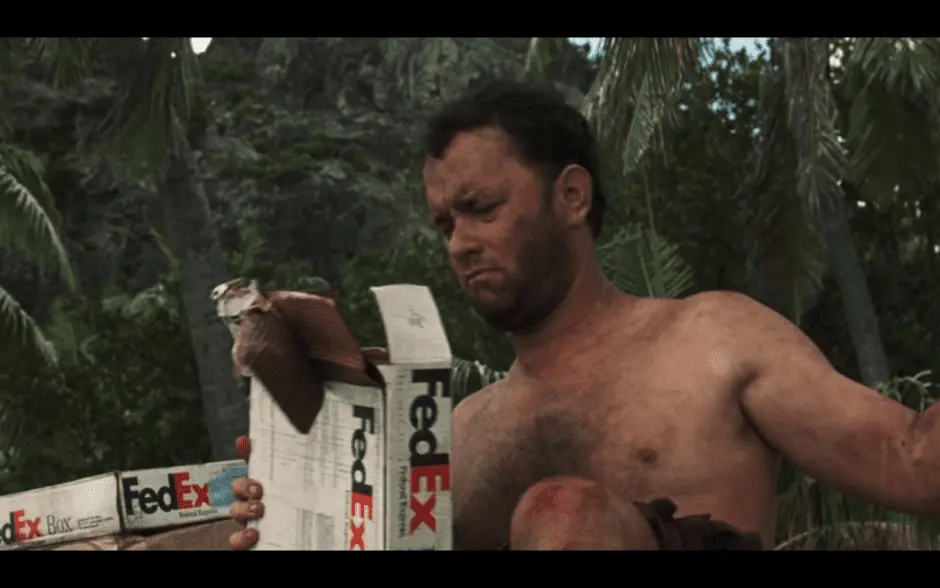
The main goal of stealth marketing is not to generate immediate revenue or sales but to instead create awareness, interest, and excitement around a brand and its products. This advertising strategy will likely lead to consumers being more receptive to direct advertising later on down the road.
And it’s a low-cost marketing strategy that can be incredibly valuable to a business.
While implementing a guerrilla marketing campaign such as stealth marketing, marketers can do away with repetitive and costly marketing exposure and rather focus on cost-effective strategies like product placement.
Examples of Stealth Marketing
Street marketing campaigns use relatively nontraditional methods and advertising spaces to gain a greater amount of brand awareness and consumer attention than traditional ad campaigns.
You’ll find street marketing placed in locations where often people wouldn’t expect to find it. Consumers expect to see advertising billboards mounted high into the sky, they expect to see ads running on eye-height screens as they walk along city streets, but they often don’t expect to see ads printed on manhole covers, infused within street art, or printed across street crosswalks.
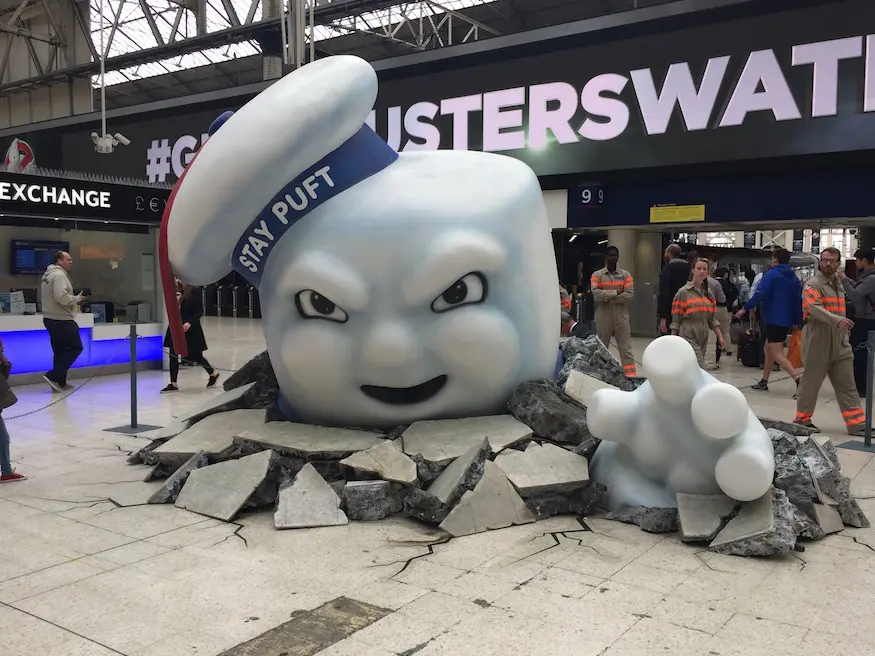
Here’s a look at how Ghostbusters used a street guerrilla marketing approach. They took over the Waterloo Railway Station in London with a huge Puft Marshmallow Man, positioned there before a movie release.
Consumers are used to seeing advertisements on city billboards and the like but they are not used to spotting ads in creative and unconventional locations.
And this is the whole point, spotting unexpected ads often makes people take notice. It may only be a moment but it’s just enough to make them start thinking about a business’ product which, more often than not, is enough to lead to a sale later on.
Examples of Street Marketing
Burger King has quite a rich history of stealing McDonald’s limelight and the Halloween celebrations of 2017 were no different.
Their #ScaryClownNight would reward the first 500 people dressed as a clown with a free whopper if they visited one of the participating stores. Burger King’s slogan for the night was “Come as a clown, eat like a king.”
This guerrilla marketing tactic also perfectly coincided with the movie release IT, a remake of the hit TV show American Horror, in which a clown cult was portrayed as one of the main themes of the story. In fact, Burger King used the horror movie release to further their plans. During the premiere, Burger King ran an ad that held the message “the moral is: never trust a clown… Burger King.”
Guerrilla Marketing tactic: Event ambush marketing
Why it worked: Burger King jumped in on the fanfare that the movie release generated, making it easy for their campaign to go viral along with the movie.
Time and Budget required: low
Marketing impact: medium
Red Bull has always been associated with high risks and even higher rewards, and nothing has ever optimized this more than jumping off a balloon from 128.100 feet and reaching 833.9mp/h (1,342km/h).
Back in 2012, an Austrian professional skydiver by the name of Felix Baumgartner smashed all kinds of records by doing just that.
Way to absolutely solidify your brand as the most kickass, thrill-seeking business that ever walked the face of the earth. The video of Felix’s jump has gained over 23 million views and has been claimed as one of the most epic stunts in freefall history.
This Red Bull event epitomizes experiential and creative marketing. There really are no limits to what a business can do to further their influence and reach over social media and to get people to notice their brand.
Guerrilla Marketing tactic: Experiential marketing
Why it worked: It was bold, it was beautiful, and it was completely crazy! Don’t be afraid to push your marketing ideas to the next level. Experiential marketing ideally leaves a huge impression on your customers. Take your creative marketing ideas and don’t hold back.
Time and Budget required: huge
Marketing impact: massive
The car company Volkswagen has been known to take its brand well beyond the realms of the automotive industry.
In this guerrilla marketing example, they created a concept called “the fun theory”. This concept was inspired by moving people’s usual behavior patterns and encouraging them to do something out of the ordinary.
To achieve this, the Volkswagen team created a piano staircase leading in and out of a subway stop. The staircase was positioned right next door to an escalator and was intended to break commuters’ habits of taking the escalator and instead play a bit of music as they walked up or down the staircase.
The musical staircase led to an increase in stair use by 66%.
On the surface, you may be puzzled as to why Volkswagen opted to take this approach, it doesn’t seem very car company-like. However, the reason this experiential marketing strategy is so brilliant is that it connects with people’s emotions. In this case, their need for fun.
Associating your business with emotion in this way can be massively beneficial. It bolsters relationships with customers that are long-lasting and quite loyal.
Guerrilla Marketing tactic: Experiential marketing
Why it worked: Guerrilla marketing ideas don’t always have to directly involve your brand’s product or service. As long as it creates a positive reflection of your business, the strategy is more than worth your while.
Time and Budget required: medium
Marketing impact: high
Kit Kat has always been about reminding people to take a break, I’m sure you’ve heard their well-patented slogan by now “Take a break, have a Kit Kat”. To leverage this well-known slogan and celebrate the release of the “Android Kit Kat”, Kit Kat decided to take its marketing to the streets by making a unique bench challenge.
To do this, the Kit Kat team placed unique outdoor ads at various locations throughout Amsterdam and Utrecht. The ads encouraged passer goers to take a break on a one-person bench seat that was attached to big Kit Kat signs. If you happened to be the lucky one to be taking a break at just the right moment, you’d win a brand new Nexus 7 tablet.
The campaign turned out to be a huge success. Wannabe “break takers,” that had missed out on being the first to claim the seat, offered participants money to take their place, cafe owners and good samaritans brought coffee, and a large crowd gathered to watch a scooter-bound delivery driver drop off a well-deserved new Nexus 7 tablet.
Guerrilla Marketing tactic: Street marketing
Why it worked: Finding new and creative ways that won’t blow your marketing budget is imperative to stand out from the crowd. For a relatively low cost, Kit Kat leveraged free social media management tools to catch public attention and create a substantial uptick in their social media engagement.
Time and Budget required: low
Marketing impact: medium
Coca-Cola is probably the mother of all guerrilla marketing examples. They’ve partnered up with FIFA, the Soccer World Cup, and the Olympic games, they used customer names on their labeling to entice purchases, and they’ve even written catchy tunes like their song “Hilltop” to ensure the success of their marketing campaigns.
But nothing could be more shocking than their brutally honest and hugely surprising admission that their products have contributed to the health decline of many Americans.
In a series of advertisements, they claimed: “...we’re using our marketing expertise and scale to educate people about the importance of making informed choices and balancing calories in and calories out.” and “We’re also telling people about all that we’re doing to help them lead active, healthy lives…”.
Not exactly the message you’d expect to hear from a company like Coca-Cola. But, hey, if not for any other reason it certainly got people and the media talking. Critics from USA Today, the Guardian, and Food Politics all publish content and talk about the campaign.
You know what they say, any press is good press. And, from Coca-Cola’s perspective, any buzz is good buzz marketing.
Guerrilla Marketing tactic: Buzz marketing
Why it worked: This guerrilla marketing tactic was definitely unconventional and, probably to most people, exactly the opposite of what you’d expect out of Coca-Cola. This is the brilliance of the campaign, however, it got people and the media talking, it spread the company’s new look attitude, and it’s the perfect example of buzz marketing.
Time and Budget required: low
Marketing impact: high
Guerrilla marketing is a seriously powerful form of marketing, and if implemented well can be the low-cost, yet potent marketing strategy that your business could use to break ahead of the competition. If you’re ready to implement these creative tactics and grow your brand, explore our pricing plans to start your own referral program today.
Just like any good guerrilla fighter, throw in a few unorthodox methods, toss in a bit of risk, and be prepared to be a bit controversial. You’ll be well on your way to taking your business to the next level.
Here are a few articles that we think you might like:
Brody Hall is a digital nomad, content writer, and SEO buff. He quite enjoys sharing his knowledge of environmentalism, self-care, and board sports. You will often find him enjoying an early morning coffee while checking his local surf breaks. If you feel like a chinwag, find him on LinkedIn.
Grow your sales at a ridiculously
lower CAC.